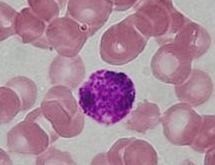Basopenia
| Basopenia | |
|---|---|
 | |
| A peripheral blood basophil stained with a Romanovsky stain. | |
| Specialty | Hematology |
Basopenia (or basocytopenia) is a form of agranulocytosis associated with a deficiency of basophils.[1] It has been proposed as an indicator of ovulation.[2] It is difficult to detect without flow cytometry, because normal levels are so low.[3] It can be defined as less than 0.01 x 109 / L.[4] Basopenia has been observed in a number of conditions, including after the administration of corticosteroids and in disease states such as chronic urticaria and lupus.[5]
Mechanism
[edit]Basophils, which account for a small proportion of the total leukocyte count, are phagocytic. Heparin, histamine, and serotonin are found in the basophilic granules. Mast cells are tissue basophils that are similar to blood basophils. Mast cells are normally not found in peripheral blood and are only rarely found in healthy bone marrow. Chronic inflammation is assessed using basophil counts. Although there is a positive correlation between higher basophil counts and high blood histamine concentrations, this correlation is not indicative of cause and effect.[6]
Associated conditions
[edit]- Hereditary absence of basophils (very rare)
- Elevated levels of glucocorticoids
- Hyperthyroidism or treatment with thyroid hormones
- Ovulation
- Hypersensitivity reactions
- urticaria[7][8][9]
- Anaphylaxis
- Drug-induced reactions
- Leukocytosis (in association with diverse disorders)
References
[edit]- ^ "Definition: basophilic leukopenia from Online Medical Dictionary".
- ^ Soni R, Bose S, Gada D, Potnis V (October 1996). "Basopenia as an indicator of ovulation (a short term clinical study)". Indian J. Physiol. Pharmacol. 40 (4): 385–8. PMID 9055113.
- ^ "CLS_3223_Unit 03_WBC". Archived from the original on 2009-01-30.
- ^ "Pathology".
- ^ Shah, Hemali; Eisenbarth, Stephanie; Tormey, Christopher A; Siddon, Alexa J (January 1, 2021). "Behind the scenes with basophils: an emerging therapeutic target". Immunotherapy Advances. 1 (1). Oxford University Press (OUP): ltab008. doi:10.1093/immadv/ltab008. ISSN 2732-4303. PMC 9327101. PMID 35919744.
- ^ "Basophil count". Nursing Critical Care. 14 (4). Ovid Technologies (Wolters Kluwer Health): 35. 2019. doi:10.1097/01.ccn.0000559778.07144.9d. ISSN 1558-447X. Retrieved November 16, 2023.
- ^ Lourenço FD, Azor MH, Santos JC (May 2008). "Activated status of basophils in chronic urticaria leads to interleukin-3 hyper-responsiveness and enhancement of histamine release induced by anti-IgE stimulus". Br. J. Dermatol. 158 (5): 979–86. doi:10.1111/j.1365-2133.2008.08499.x. PMID 18341658. S2CID 2935740.
- ^ Grattan CE, Dawn G, Gibbs S, Francis DM (March 2003). "Blood basophil numbers in chronic ordinary urticaria and healthy controls: diurnal variation, influence of loratadine and prednisolone and relationship to disease activity". Clin. Exp. Allergy. 33 (3): 337–41. doi:10.1046/j.1365-2222.2003.01589.x. PMID 12614448. S2CID 30477970.
- ^ Grattan CE, Walpole D, Francis DM (December 1997). "Flow cytometric analysis of basophil numbers in chronic urticaria: basopenia is related to serum histamine releasing activity". Clin. Exp. Allergy. 27 (12): 1417–24. doi:10.1046/j.1365-2222.1997.1630972.x. PMID 9433937.
